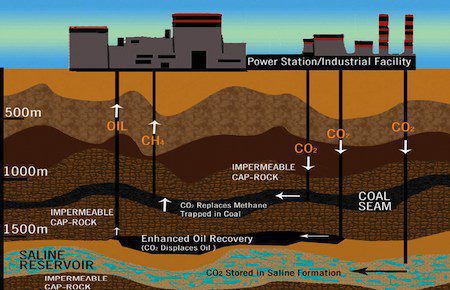
Is CO2 sequestration a solution? New research say no
A husband and wife team of professors has clean coal supporters in a snit over a recent report suggesting that geologic storage of CO2 – an essential component of the carbon capture and storage (CCS) technology upon which “clean coal” rests – will never be viable at the scale required to make any difference. Not even close, the study asserts.
The report by Michael Economides of the University of Houston, an “avowed climate skeptic” (who apparently has the honor of making on Senator James Inhofe’s “list of 400“), and his wife Christine Ehlig-Economides of the Department of Petroleum Engineering at Texas A&M University, asserts that sequestering the emissions of just one commercial scale CCS plant would require a geologic repository the size of a “small U.S. state”.
The paper argues that pressure in underground aquifers could increase to the point where no more CO2 could be pumped into it, or that the surrounding rock would eventually leak the gas into surrounding areas, and possibly back into the atmosphere, making the entire exercise “worthless”. The study claims that most previous models underestimate by “5 to 20 times” the amount of space needed for carbon sequestration.
“The findings of this work clearly suggest that [geological sequestration] is not a practical means to provide any substantive reduction in CO2 emissions”, the report says, “although it has been repeatedly presented as such by others.”
The physics is so straightforward,” Ehlig-Economides told Reuters.”When you try to inject something into an existing formation which is already at pressure, it (the pressure) has to go up,” she told Reuters on Monday. “The models that people are using more often than not do not accommodate this.”
And thus the ruckus began, with a host of geologists, green advocacy groups, engineers, and business leaders assailing the study as highly flawed, shot-through with “shoddy assumptions and inaccurate assumptions”.
This is two people against the entire scientific community,” said George Peridas from the Natural Resources Defense Council. Peridas criticizes the study on his blog, stating essentially that the Econmides’ simply “get it wrong.”
One has to wonder how they expected a paper as flawed as this this to withstand scientific scrutiny, or what the motivation behind its publication is,” Peridas writes in his NRDC blog Switchboard.
Sean McCoy, a senior engineer at Carnegie Mellon University cut to the chase:
I am of the opinion that this paper should never have made it though peer review in the published form,” he said.
Despite the sharp criticism, the duo stands firm:
I know we are right,” says Economides, adding that the criticisms mounted against the study’s conclusions are “nonsense.”
I was a petroleum engineer for many years,” he says, “and soon realized that geologists did not understand flow and the laws of physics, against which you can’t argue…”
“Go back and take a fresh look at what we said. Take a geoengineering class,” he advises his critics.
So what does it all mean?
Where does this leave the “average Joe” interested enough in the real world to attempt understanding the issues of climate change and energy sustainability? Even more confused, I imagine, though the whole idea of “clean coal” and CCS technology has always found a skeptic in me, as I’ve written about on numerous occasions. A skepticism reinforced last year when I visited Schwarze Pumpe, the CCS pilot project in northeastern Germany.
Joe Romm, a Center for American Progress fellow and publisher of the uber-climate change blog Climate Progress, thoroughly discusses the source of such skepticism in those of us that hold only faint hope at best that CCS will serve as a “solution” to continued reliance on coal as a primary energy source.
Realistically, it has always been hard to see how CCS could be more than a small part of the solution to averting catastrophic climate change,” says Romm.
As the ongoing disaster in the Gulf of Mexico illustrates, I think skepticism in the future viability of fossil fuel extraction and burning is entirely warranted. We should as a matter of course be wary of technologies offering “safe alternatives” to the worst consequences of their use. When something catastrophic happens, the words of those that previously claimed it could never happen ring hollow.
Regarding who is right in the brouhaha caused by the report Economides report, I can’t say. I’m not a geologist or petroleum engineer.
My opinion remains unchanged that there is no such thing as clean coal.
Additional sources and further reading:
World Resources Institute
TriplePundit
ClimateWire (subscription required)
Image credit: Logan, J., J. Venezia, and K. Larsen. 2007. Opportunities and Challenges for Carbon Capture and Sequestration. Washington, DC: World Resources Institute


